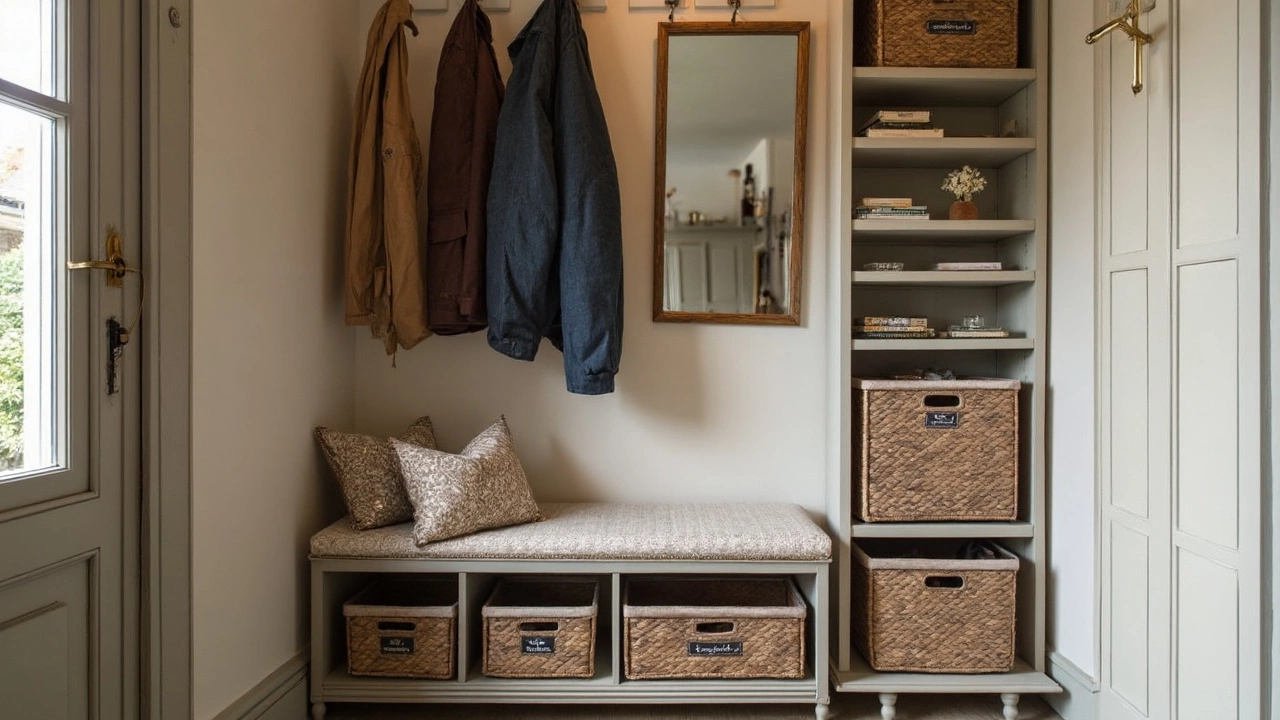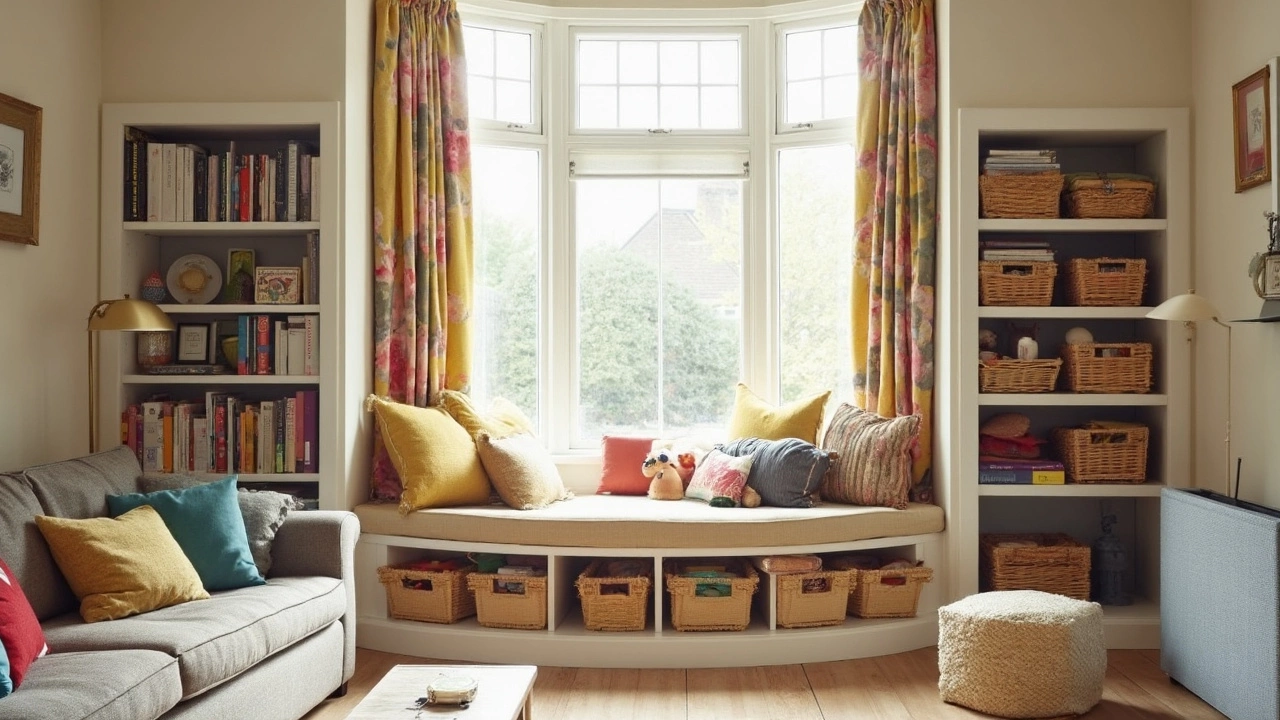If you feel like your house was designed by someone who never had kids, pets, or hobbies, you’re not alone. So many of us battle clutter simply because there’s nowhere to put anything—no spare closet, no garage, not even a broom cupboard. So where do you start when your home just doesn’t have built-in storage?
First thing: stop blaming yourself for the chaos. Most homes are set up for looks, not living. But that doesn’t mean you’re stuck with piles of stuff everywhere. The trick is making every bit of space pull double duty—think under beds, behind doors, even the sides of your fridge. These spots can become stash zones with the right baskets, hooks, or simple shelves.
Don’t overlook furniture that hides clutter, like storage ottomans or a bed with drawers underneath. You can even swap out things like nightstands or coffee tables for versions with hidden compartments. Multifunctional furniture is basically a non-negotiable when space is tight.
- Why Do Houses Lack Storage?
- Storage Mindset: Think Like a Minimalist
- Furniture That Works Harder
- Hidden Spots That Everyone Overlooks
- Vertical Storage Tricks
- Smart Swaps and Daily Habits
Why Do Houses Lack Storage?
Have you noticed the newer the house, the worse the storage? That’s not your imagination. Many homes built after the 1980s just don’t have much built-in storage. Builders cut storage corners to save money or fit more rooms into a smaller footprint. Older homes aren’t much better—they were designed back when people owned way less stuff. This is especially true for closets. The National Association of Home Builders even found that only about 60% of homes built since 1999 offer a coat closet.
Builders also assume buyers want open floor plans and bigger living spaces, so sacrifices get made. Pantries get tinier, laundry rooms vanish, and attic space is given up for higher ceilings. The result? Nowhere to stash cleaning supplies, sports stuff, out-of-season clothes, or toys. You’re left cramming everything under beds or behind doors.
| Home Feature | Typical Space (New Homes, post-2000) | Typical Space (Older Homes, pre-1970) |
|---|---|---|
| Bedroom Closets | 24–36 inches wide, often sliding doors | Small (if any), sometimes just a wardrobe |
| Pantries | 2–4 feet wide, shallow shelves | Walk-in or none (depending on region) |
| Laundry Storage | Stacked or closet-style, few cabinets | Separate room, more shelving |
We also tend to have way more stuff than our parents did—think seasonal decor, sports gear, or tech gadgets. Modern lifestyles demand way more storage than old floor plans offer. The home storage struggle comes down to a mix of changing design trends and the simple fact that families today need space for way more.
Storage Mindset: Think Like a Minimalist
If you keep bringing stuff home but never get rid of anything, even the best home storage tricks won't work for long. You have to shift your mindset. This doesn’t mean throwing out everything you love—it’s about getting picky about what stays and creating habits that prevent clutter from piling up in the first place.
Minimalist living doesn’t automatically mean white walls and two chairs. Studies from UCLA’s Center on Everyday Lives of Families found that American homes are bursting at the seams, with most families using only 40% of their available living space. When you live in a spot with zero storage, every item needs to pull its weight. If something doesn’t get used, fix it, donate it, or say goodbye.
Here’s how to flip your thinking when it comes to household stuff:
- One in, one out: For every new item that comes in—shoes, kitchen gear, board games—get rid of an old or unused one. This helps keep storage in balance.
- Stop buying “just in case” stuff: If you haven’t needed it in the last year, chances are you can live without it. Most backup items just collect dust.
- Store only what you love or use: If you keep moving that random appliance or ugly mug from place to place, maybe it’s time to part ways.
It helps to know what you're working with. Write down your actual storage options—under bed, over cabinets, wall space, etc.—so you can get creative. Try this:-
| Area | Potential Storage? (Yes/No) | Notes |
|---|---|---|
| Under Beds | Yes | Flat bins, vacuum bags great for off-season stuff |
| Above Cabinets | Yes | Store rarely used gear in baskets |
| Behind Doors | Yes | Hooks or organizers for coats, bags, cleaning tools |
| Hallways | Usually No | But slim shelves or shoe storage sometimes possible |
Remember, the best storage plan is simple: don’t organize what you can let go of. Clearing out is always step one, even if you have kids and a cat who somehow collect more stuff than you ever bought. Once you see what you truly need, even a house with zero closets feels way more manageable.
Furniture That Works Harder
When every inch counts, boring furniture just won't cut it. Multifunctional pieces are a game-changer, especially if you're short on closets or cabinets. Ottomans with lift-up tops, sofa beds, and benches with hidden compartments give you places to stash stuff without eating up extra floorspace. These upgrades don’t just look good—they hold secret stashes of everything from blankets to board games.
Take platform beds, for example. IKEA’s MALM series is famous for those roomy pull-out drawers underneath. I use mine for storing off-season clothes and spare sheets—they stay dust-free and out of sight. Want your coffee table to do more? Look for one with lift-top storage so you can chuck in toys, remotes, or even Whiskers’ cat toys in a flash before guests show up.
Don’t forget about kitchen and dining spaces. Banquette seating—think bench built into the wall—often has lift-up seats that hide kitchen gadgets or bulk foods. If your kitchen is tiny, rolling kitchen islands double as extra prep space with shelves or drawers for extra pots and pans.
- Swap nightstands for three-drawer filing cabinets for bedrooms
- Use a bench with cubbies in the entryway to store shoes, backpacks, or pet leashes
- Look for bookcases with baskets or bins on the bottom shelf for hidden clutter zones
| Furniture | Average Hidden Storage Capacity | Price Range (USD) |
|---|---|---|
| Storage Ottoman | 2-4 cu. ft. | $60-$150 |
| Platform Bed with Drawers | 20-25 cu. ft. | $250-$600 |
| Lift-Top Coffee Table | 1-3 cu. ft. | $90-$250 |
| Banquette Bench | 3-8 cu. ft. | $180-$400 |
It’s all about making everyday objects pull double duty. When you maximize furniture as storage, you unclutter your space without adding bulky storage bins everywhere. If you have kids—or even just a cat who loves chasing things—keeping stuff out of sight but close at hand is a real lifesaver. This approach can pack home storage into places you'd otherwise overlook.

Hidden Spots That Everyone Overlooks
It’s wild how many storage spots are hiding in plain sight. Here’s the truth: most people never use at least 30% of the possible storage in their home just because they overlook weird corners or think you only store stuff in closets. But if you look around with fresh eyes (I like to call it the "desperate parent scan"), you’ll see new possibilities for home storage almost everywhere.
Under furniture is a goldmine. The space beneath the couch, chairs, and beds is usually just collecting dust bunnies. Grab a few low bins, label them, and slide seasonal clothes, shoes, or even board games underneath. Some beds come with built-in drawers, but if yours doesn’t, flat plastic totes work just as well.
Look up and you’ll notice the airspace above doors and cabinets, which is prime real estate for shelves. Just mount a simple shelf above the bathroom door for extra towels or in the kitchen for those gadgets you hardly ever use. Don’t forget the tops of wardrobes and the fridge—put a couple of baskets or bins up there for paper towels or pantry backups.
Doors aren’t just for closing off rooms. Hang organizers on the backs of bedroom, bathroom, or even cabinet doors. We use one in our bathroom for cleaning supplies and it keeps everything out of reach from curious little hands (and paws—looking at you, Whiskers). Over-the-door hooks also make instant homes for bags, scarves, or even kitchen utensils.
Staircases can be sneaky, too. The wall space along the side is perfect for slim bookshelves or hooks, and if you really want to go big, some people turn each step into its own storage drawer. If you’re renting or just not ready for DIY, baskets at the bottom or top of the stairs corral items waiting to be put away.
Last tip: the side of your fridge is magnetic, literally. We have a magnetic spice rack stuck to the side, which frees up tons of counter space. You can also stick up baskets for mail, keys, or those random store coupons that never have a real home. Always look for everyday dead zones that a small shelf, hook, or basket could transform into actual storage.
Vertical Storage Tricks
This is where the real magic happens. When you run out of floor space, look up. Walls are goldmines for storing stuff—especially in tight rooms where there’s just no extra square footage. Experts say using vertical space can boost storage by up to 40% in a small home.
Lining your walls with shelves is the classic move, but you don’t need to stop with just one or two. Stack shelves all the way up to the ceiling—don’t worry if you need a stool once in a while, just stash the stuff you rarely use up top. Tall bookcases, pegboards, and wall-mounted racks all punch way above their weight here.
- Put hooks behind doors for purses, backpacks, even hairdryers or cleaning gear. I’ve hung everything from umbrellas to sports gear behind my kids’ doors, and it clears the chaos fast.
- Use magnetic strips on walls in the kitchen—think knives, spice jars, or metal tools. It frees up precious drawer and countertop space.
- Try a hanging organizer inside the pantry for snacks, packets, and odds and ends. Even the inside of cabinet doors can hold spice racks or bag holders.
- Install floating shelves in awkward nooks—above toilets, next to windows, or in hallway corners. These spots get ignored, but they’re storage gold for towels, books, or even cat supplies (Whiskers has a dedicated shelf for treats and brushes).
- In kids’ rooms, use wall-mounted bins or baskets for stuffed animals or art supplies. We did this in Silas’s room, and even building blocks now have a home off the floor.
If you want a quick look at how different options stack up, here’s a handy table:
| Vertical Storage Option | Best For | Extra Tip |
|---|---|---|
| Wall-mounted shelves | Books, decor, baskets | Go all the way to the ceiling |
| Pegboards | Crafts, tools, kitchen gadgets | Customizable hooks and bins |
| Over-the-door racks | Shoes, cleaners, toiletries | Works on most standard doors |
| Magnetic strips | Knives, tins, tools | Safe, easy access in kitchens and workshops |
| Wall baskets/bins | Toys, mail, pet gear | Label bins for easy cleanup |
Using vertical tricks isn’t about cramming more stuff in—it’s about making your things visible and reachable. Trust me, once you get in the groove, you’ll wonder how you ever survived without home storage hacks like these.
Smart Swaps and Daily Habits
Storage isn’t just about where you put things—it’s about what you actually own and how you use it every day. Swapping out bulky stuff for sleeker options, or doubling up on use, pays off fast. For example, ditching plastic food containers missing their lids (we all have them) and buying a set that neatly nests together suddenly frees up a whole kitchen drawer.
Making tiny swaps around the house adds up. Swap your towel rack for wall hooks—that way, every family member gets their own spot, and you’re not dealing with towels falling everywhere. Instead of stacking shoes by the entry, try a slim vertical rack that holds way more but takes up almost no floor space. In the kids’ room, I swapped toy bins for clear under-bed storage, so cleanup is way quicker. That trick is a lifesaver before company comes over.
If you want your house to stay organized, you need daily habits that take barely any time:
- Home storage works best when you actually put things back after using them. Train yourself and the family with a simple five-minute tidy at the end of each day.
- Try the “one-in, one-out” rule for stuff like toys and clothes. If something new comes in, something old makes an exit.
- Keep a donation box in a handy spot—when you trip over or get annoyed with something, into the box it goes. Drop it off whenever it fills up.
- Stick to a regular sweep of clutter zones: the mail pile, junk drawer, entryway, and bathroom counter. A quick reset once a week can prevent big headaches.
You can make big changes with these small habits. Studies have shown that people who tidy up daily spend about 40% less time doing deep cleaning compared to those who let clutter build up. That’s a lot of time back for yourself.
| Swap | Space Saved | Extra Benefit |
|---|---|---|
| Traditional nightstand to wall shelf with hooks | 1-2 sq ft per room | Extra spot for bags/hats |
| Bulky toy box to under-bed rolling bins | 3-5 sq ft | Hidden, easily cleaned up |
| Lidless food containers to stackable sets | 1 full kitchen drawer | Less frustration hunting for lids |
| Bench to storage ottoman | 2-3 sq ft | Seating + hidden storage |
| Entry mat to shoe rack tower | Floor freed up | No more tripping hazards |
If you turn these swaps and simple habits into a routine, you’ll notice the difference almost instantly—and you can finally stop that endless cycle of picking up, losing things, and feeling swamped.
 EN
EN
 HR
HR
 AR
AR

